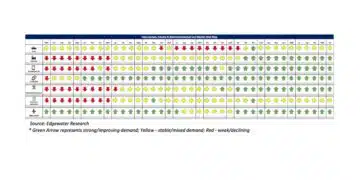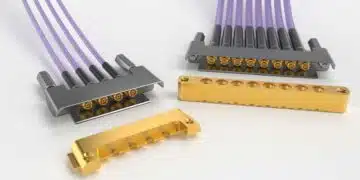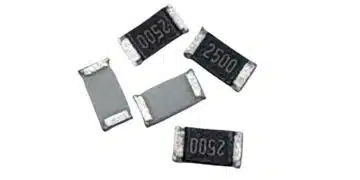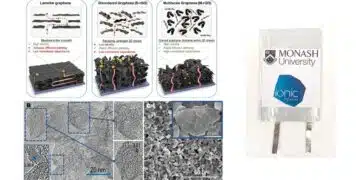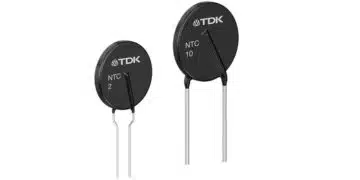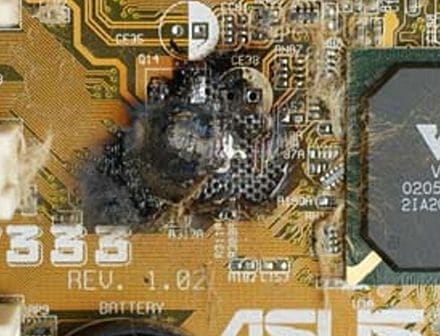source: Embedded article
Ron Neale, March 14, 2016
Recently on EETimes.com, Max the Magnificent considered what was described as The Great Capacitor Plague of the Early 21st Century. This prompted several readers to comment reporting various levels of experience with recent capacitor problems. However, a few smudges on printed circuit boards, some smoke, and the occasional flame all pale into insignificance with regard to the experiences of capacitor users in times past.
In the middle and latter part of the 20th century, it was almost a rite-of-passage for anybody making claims on the electronic engineering profession to have sat through a storm of aluminium flakes, paper, fluffy chemicals, and heaven knows what else that rained down following the explosion of an electrolytic capacitor.
What follows is a true story of how an exploding capacitor delayed the development of part of the British computer industry by at least six months. The name of the individual involved has been withheld to avoid embarrassment. We will call him “The Young Man,” or TYM for short.
Setting the scene
This exploding capacitor story starts long ago in a distant place, when transistors made of germanium were in their infancy and magnetic cores were the memory of choice for the latest embryo electronic computers. The distant place is Croydon, England, now a part of greater London, once famous as the site of the first London airport, perhaps now more celebrated for a ladies’ hair style named “The Croydon Face Lift.”
The airport had spawned number of light engineering electronics companies, including Philips/Mullard (radios and televisions), ICT/ICL by their earlier name of Powers-Samas (tabulators and computers), Creed (teleprinters), Dictaphone and Muirhead (fax machines), Aeronautical and General Instruments (AGI) (aviation instruments), and many more, all moving by various degrees into electronics.
Now visualize a bespectacled school leaver — TYM, who is central to this story as a very young man — who had bicycled around all these companies to find out what they were about. TYM finally ended up knocking on the door of Powers-Samas — which was to evolve into International Computer & Tabulators (ICT), then International Computers Limited (ICL), and eventually Fujitsu — asking if there were any jobs working on electronic computers. He had an interest in electronics, he’d built a few vacuum tube and germanium transistor radios, and he had also won the Physics prize as his most significant grammar school academic achievement. He was directed to the training school. In those days, large engineering companies in the UK ran training schools, offered formal engineering apprenticeships, and paid for employees to attend college and/or university. Here TYM met a kindly Mr Wood who managed the training school and who listened sympathetically to TYM’s electronic engineering dreams and employment requests.
This is the point in our tale where luck steps in and plays its part, because Mr Wood was a mechanical engineer who knew very little about electronics, as was the case with most of the senior and middle management of Powers-Samas / ICT at that time. However, Mr Woods had recently been visited by the head of the physics department at the local technical college, who was recruiting students for his department. For TYM, Mr Woods then uttered some life-changing words: “Physics is halfway between Mechanical Engineering and Electronics, so we will pay you to study Physics with Electronic Engineering as your Applied Physics subject, and we will employ you as a Mechanical Engineering Apprentice.” All of this was undertaken on a day(s) release program.
Sometime later…
While studying during the following years, TYM was provided with experience in the design and manufacture of all manner of machines involving punched cards and their associated mechanical engineering, while at every opportunity trying to associate himself with any electronics-related developments. As a result of endless pestering, TYM found himself as a know-it-all kid attached to a very small select group of top-class electronic computer design engineers who were developing the first British ferrite core-based computer in secret. Along the way, TYM had some development contact with another secret company computer called the Samastronic, which was a machine constructed by highly-skilled mechanical engineers as their best effort at computer building. TYM also carefully avoided any involvement with the company’s first all vacuum tube electronic program controlled computer — the PCC — which managed to become a disaster without TYM’s help.
The new computer, which was called the FCC (Ferrite Core Computer), had all the architectural features of a modern single-chip processor or microcontroller using discrete components. The program and data memory were magnetic core, some of the magnetic core drivers were vacuum tubes (good old EL34s), while the arithmetic unit was implemented using diode transistor logic (DTL). The diode part of the DTL employed the very fast IN96 point-contact germanium diode — a device that will feature later in this exploding capacitor story. The high-speed scanning for one co-ordinate of the core memory used a modified version of a nuclear weapon coaxial cable trigger device. The computer programs were loaded into the computer with paper tape or punched cards or a simple keyboard. There may have been a teleprinter as the output device.
As a very junior member of the team, TYM was provided with an excellent opportunity for learning from some of the very best computer designers in the country/world, and to carry out small circuit development tasks. One day, somebody must have looked at TYM’s company experience resume and seen that he had been involved in the design and construction (mostly construction) of the power supply for a machine that could photo-electrically read pen or pencil marks on a punch card and punch holes in the correct locations. Thus it was that TYM was given the job of designing one of the many FCC power supplies — the one for the high voltage required by the vacuum tubes.
TYM set to work on a design for a power supply that would have a front panel that fitted in a standard 19-inch rack, with most of the circuit components mounted on a board fixed at right angles. The design was conventional by today’s standards — a transformer, a full wave rectifier, and a vacuum tube-based feedback circuit featuring a neon gas tube as the voltage reference source accompanied by a large electrolytic capacitor to deal with current surges. There were also a few ancillary components like fuses, fixed and variable resistors, and a voltmeter.
The design was reviewed by TYM’s immediate superior who approved it and reminded him to make sure the capacitor was “formed” before installing it. In those days, electrolytic capacitors required forming before use, especially after any significant time “on the shelf.” This forming involved applying a staircase waveform of increasing voltage steps, where each step voltage was maintained for a few hours.
Explosive times
When the power supply was completed, it was installed in its position among the others on the rack. The complete computer occupied four 6-foot racks linked together with the memory stacks cantilevered out. All went well for a few days and the power supply did its job perfectly…
…until one day when, during the quiet of the afternoon, the computer development lab (indeed, the whole building) echoed with the sound of a massive explosion that filled the computer room with a mixture of aluminium confetti, fluffy chemical fallout, and smoke, all followed by what sounded like machine gun fire.
The senior engineer on the project rushed from his office, peered through the smoke and settling dust at the smoking ruins of his prototype FCC, and demanded an explanation, not of TYM (fortunately), but of the senior team leader — the strict hierarchy of command and responsibility protected TYM. The team leader explained that he thought a large defective electrolytic capacitor in a power supply had exploded. The answer to the next question — “Why are all the arithmetic unit circuit boards smoking and all the DTL diodes and transistors so much broken glass and bent wire on the floor?” — explained the machine gun-like sound that had followed the initial explosion. It would appear that the explosion had somehow provided a 400-volt surge to the 5-volt devices on the arithmetic unit board. The machine gun fire sound was caused by the chain reaction of exploding diodes and other components as the 400-volt power surge progressed through the various circuits.
The team was instructed to not let this happen again. A few weeks or a month or so later, all the damaged boards had been rebuilt and replaced, and the power supply had been rebuilt exactly as before. This time the electrolytic capacitor was formed and double checked. The development and the collection of performance data continued until, once again on an otherwise quiet afternoon, the computer room was rocked with a repeat explosion of the same capacitor.
This time some precautions had been taken to prevent much of the earlier chain reaction damage. Even so, some damage to other boards and power supplies occurred. After much by way of raised voices and robust discussion in the chief engineers office (expletives deleted), careful analysis showed the explosion had forced the cantilevered circuit board of TYM’s power supply down onto a power supply below it and there was evidence of a massive arc.
Things were now getting serious. Jobs were at risk. Eventually, careful analysis by the full engineering team of the offending power supply and its design tracked-down the culprit. Neon gas tubes used as voltage reference sources for power supplies get very hot, so placing one on a circuit board next to an electrolytic capacitor is not the best design move. Lesson learned.
A few months later, the FCC was back on course. Eventually, in the early 1960s, half a dozen were built and deployed in the market as the ICL/ICT 558 Computer. By that time, the machine was at least six months late and not the most competitive of machines. TYM suspects that by that time the computer may have had a different power supply design, but he could not be sure as he had moved on to the physics lab in the same company and was now pursuing the development of ferroelectric memory based on triglycene sulphate and barium titanate and multi-aperture ferrite memory — MAD devices.
TYM pursued his career in electronics in various parts of the world peppered with other explosions, some more serious including — along the way — some very large ones underground in Nevada. Sometimes, TYM could be found bathed in the blue light of Cherenkov radiation while crawling around atop of the nuclear reactor at the Wright Patterson USAF base pursuing dreams of radiation-hard memory components.
Rumours that TYM’s attempts to produce low-cost, thin-film, radiation-hard squib firing switches for the wire-guided Dragon missile delayed its deployment into the US military arsenal by six months are totally without foundation (it was a difficult development for many reasons).
In later life, after a long career in electronics, TYM was often found masquerading as a technical journalist and on the lecture circuit. He could frequently be found at his favorite diner — the Pinecrest Restaurant at Mason & Geary in San Francisco — or at one of his many other favorite eateries, especially the Moss Beach Distillery at Half Moon Bay, California. Questions as to why these meetings were often held in the company of a much younger female purser/cabin attendant from United Airlines or a female PR executive are dismissed by TYM as merely selective observation. He informs us anybody suggesting anything to the contrary can expect to hear from his legal team.


